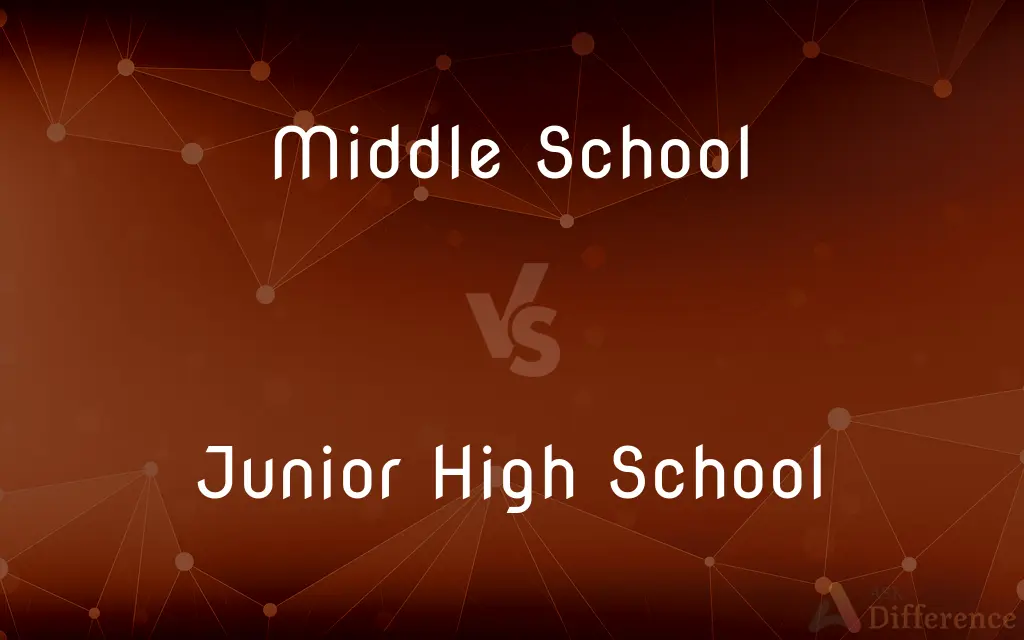Middle School vs. Junior High School — What's the Difference?
Edited by Tayyaba Rehman — By Fiza Rafique — Published on January 9, 2024
Middle School typically serves grades 6-8; Junior High School often includes grades 7-9. Both bridge elementary and high school education.

Difference Between Middle School and Junior High School
Table of Contents
ADVERTISEMENT
Key Differences
In the U.S. educational system, the term Middle School is commonly used to describe an institution that educates students usually in grades 6-8. On the contrary, Junior High School generally refers to schools that cater to students in grades 7-9. Both institutions serve as a transitional phase between elementary school and high school.
The concept of Middle School evolved to address the unique developmental needs of early adolescents. This institution focuses on an interdisciplinary approach to education, integrating subjects for a holistic learning experience. On the other hand, Junior High School traditionally mirrored the high school model more closely, with students often switching classes and having a broader range of subjects.
Historically, Junior High School came into existence before the advent of the Middle School concept. The former was designed to provide more rigorous curriculum options for students who had outgrown the elementary setting. In contrast, the emergence of Middle School was more in response to the distinctive physical, intellectual, and emotional changes students undergo during these years.
While many districts have now shifted to the Middle School model, the Junior High School structure can still be found in some regions. Both forms aim to prepare students for the challenges of high school. Nevertheless, there might be differences in curricular emphasis and pedagogical approach based on the institution's foundational principles.
Regardless of the terminology or grade configuration, the primary purpose of both Middle School and Junior High School remains consistent: to offer students a supportive environment where they can grow academically, socially, and emotionally before they step into the more demanding realm of high school.
ADVERTISEMENT
Comparison Chart
Typical Grade Levels
Usually grades 6-8
Often grades 7-9
Pedagogical Approach
Interdisciplinary approach
Closer to the high school model
Historical Emergence
Evolved after Junior High
Preceded Middle School
Primary Focus
Addresses unique developmental needs
Originally for a rigorous curriculum beyond elementary
Prevalence
More common today
Less common, but still exists in certain regions
Compare with Definitions
Middle School
Middle School often focuses on interdisciplinary learning.
In Middle School, her projects often combined multiple subjects.
Junior High School
Junior High School can be found in specific regions today.
In some parts of the state, Junior High School is still prevalent.
Middle School
Middle School bridges the gap between elementary and high school.
The transition from elementary to Middle School can be challenging for some.
Junior High School
Junior High School traditionally serves students in grades 7-9.
He's in the eighth grade at the local Junior High School.
Middle School
Middle School is an institution for students typically in grades 6-8.
She's excited about starting Middle School next year.
Junior High School
Junior High School was introduced before the Middle School concept.
Back in the day, after elementary, you went straight to Junior High School.
Middle School
Middle School addresses the unique needs of early adolescents.
Middle School counselors help students navigate puberty and peer pressures.
Junior High School
Junior High School initially offered a rigorous curriculum post-elementary.
Junior High School was designed to challenge students beyond elementary lessons.
Middle School
Middle School provides a foundation for high school studies.
What he learned in Middle School prepared him well for high school challenges.
Junior High School
Junior High School often mirrors the high school model.
Junior High School introduced him to changing classes throughout the day.
Middle School
A school at a level between elementary and high school, typically including grades five or six through eight.
Common Curiosities
Why was the Middle School model introduced?
Middle School was introduced to address the unique developmental needs of early adolescents.
Is Junior High School still common today?
While less common than Middle Schools, Junior High Schools can still be found in certain regions.
How about extracurriculars in Junior High School?
Just like Middle School, Junior High Schools also typically offer various extracurricular activities.
How does Junior High School differ in grade levels?
Junior High School generally includes grades 7-9.
How does the teaching approach vary between the two?
Middle School often adopts an interdisciplinary approach, while Junior High mirrors the high school model more closely.
Is there a difference in the school environment between the two?
While both cater to pre-teens and young adolescents, Middle Schools may have a more nurturing environment, focusing on students' developmental needs.
What grades does Middle School usually cover?
Middle School typically covers grades 6-8.
Which came first, Junior High School or Middle School?
Junior High School existed before the concept of Middle School.
Can a district have both Middle School and Junior High School simultaneously?
It's uncommon, but a district could potentially have both, depending on its structure and educational objectives.
Are extracurricular activities prevalent in Middle Schools?
Yes, many Middle Schools offer a range of extracurricular activities for student engagement.
What's the main goal of both Middle School and Junior High School?
Both aim to provide a transition between elementary and high school education, preparing students for future academic challenges.
How do students transition from either institution to high school?
Both Middle Schools and Junior High Schools have programs and counseling to help students prepare for the high school transition.
How do schools decide between adopting a Middle School or Junior High School model?
The decision often depends on historical precedents, district preferences, and educational philosophies.
Are the curriculum subjects different in Middle School compared to Junior High School?
While there may be overlap, Junior High might offer more advanced courses, aligning closer to a high school curriculum.
Do both types of schools have standardized testing?
Yes, both Middle Schools and Junior High Schools usually participate in state or district standardized testing.
Share Your Discovery

Previous Comparison
Research Problem vs. Research Question
Next Comparison
Greek Gods vs. Roman GodsAuthor Spotlight
Written by
Fiza RafiqueFiza Rafique is a skilled content writer at AskDifference.com, where she meticulously refines and enhances written pieces. Drawing from her vast editorial expertise, Fiza ensures clarity, accuracy, and precision in every article. Passionate about language, she continually seeks to elevate the quality of content for readers worldwide.
Edited by
Tayyaba RehmanTayyaba Rehman is a distinguished writer, currently serving as a primary contributor to askdifference.com. As a researcher in semantics and etymology, Tayyaba's passion for the complexity of languages and their distinctions has found a perfect home on the platform. Tayyaba delves into the intricacies of language, distinguishing between commonly confused words and phrases, thereby providing clarity for readers worldwide.














































